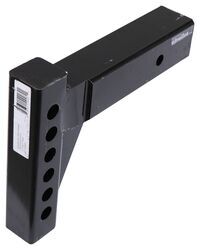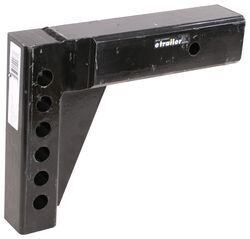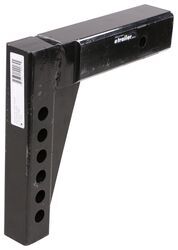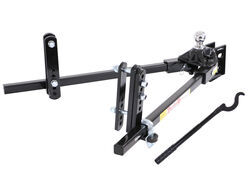
Reducer Sleeve for Equal-I-zer Weight Distribution System in 2-1/2 Inch Receiver of 2016 Ford F350
Question:
I purchased a 2016 F350 Diesel this week for towing our 25 foot Airstream. Our Equalizer Hitch has a 2.0inch shank. The Ford Receiver has a 2 1/16inch x 2 1/16th inch sleeve that fits into the 2.5inch receiver. This small thickness of a 25 cent piece is enough slop to give the Equalizer Hitch, with an exactly 2.0inch shank, an end play of 7/16inch up and down, as well left to right. With a 25 foot trailer attached, this could possibly create metal fatigue to the receiver on our Ford with this excess play. Is there a thicker sleeve to reduce this slop? Ask someone to a 2inch hitch into this sleeve and you will immediately understand my concern. We travel many undulating and irregular surfaced gravel roads in the Rocky Mountains. Getting this tighter fit would solve my issues with the hitch. How can this be done?
asked by: Ray E
Expert Reply:
The reducer sleeve does need to be a bit smaller than the interior dimension of the receiver or it could become stuck. Typically a bit of 'slop' between the shank and the receiver or in this case, the reducer and shank isn't much of a concern with a weight distribution system because the spring bars of the system are applying a good deal of upward leverage against the receiver. This is almost always enough leverage to prevent the shank from rattling around. Not in your case, however.
Since the reducer isn't doing the trick, the ideal solution would be to eliminate it and use the correct size weight distribution shank. Equal-I-zer offers three shanks designed for 2-1/2 inch receivers. For a maximum rise of 10 inches and drop of 6 inches, use # EQ90-02-4900. For a max rise of 7 inches or max drop of 3 inches, use # EQ90-02-4700 or for a max rise of 8 inches and drop of 4 inches, use # EQ90-02-4800.

Products Referenced in This Question
Equal-i-zer Weight Dist Shank - 2-1/2" Hitch - 7" Rise, 3" Drop
- Accessories and Parts
- Weight Distribution Hitch
- Shanks
- 1400 lbs TW
- Fits 2-1/2 Inch Hitch
- Equal-i-zer
- Square - 3 Inch Drop
- Square - 7 Inch Rise
- Equal-i-zer
more information >
Equal-i-zer Weight Dist Shank - 2-1/2" Hitch - 8" Rise, 4" Drop
- Accessories and Parts
- Weight Distribution Hitch
- Shanks
- 1600 lbs TW
- 16000 lbs GTW
- Fits 2-1/2 Inch Hitch
- Equal-i-zer
- Square - 4 Inch Drop
- Square - 8 Inch Rise
- Equal-i-zer
more information >
Equal-i-zer Weight Dist Shank - 2-1/2" Hitch - 10" Rise/6" Drop
- Accessories and Parts
- Weight Distribution Hitch
- Shanks
- 1200 lbs TW
- 12000 lbs GTW
- Fits 2-1/2 Inch Hitch
- Equal-i-zer
- Square - 6 Inch Drop
- Square - 10 Inch Rise
- Equal-i-zer
more information >
Product Page this Question was Asked From
Equal-i-zer Weight Distribution w/ 4-Point Sway Control - No Shank - 14,000 lbs GTW, 1,400 lbs TW
- Weight Distribution Hitch
- WD With Sway Control
- Some Sway
- Shank Not Included
- Electric Brake Compatible
- Surge Brake Compatible
- Fits 2 Inch Hitch
- Allows Backing Up
- 1200 lbs
- 1300 lbs
- Equal-i-zer
more information >
Featured Help Information
Instructions

Continue Researching
- Shop: Equal-i-zer Weight Dist Shank - 2-1/2" Hitch - 7" Rise, 3" Drop
- Article: 30-Amp and 50-Amp RV Service: What's the Difference?
- Shop: Equal-i-zer Weight Dist Shank - 2-1/2" Hitch - 8" Rise, 4" Drop
- Shop: Curt Hitch Receiver Reducer Sleeve - 2-1/2" to 2"
- Video: Review of Equal-i-zer Weight Distribution Hitch - EQ90-02-4800
- Video: Review of Equal-i-zer Weight Distribution Parts - Shank for 2-1/2 Inch Hitch - EQ90-02-4700
- Q&A: Equal-I-Zer Weight Distribution Shank for 2-1/2 inch Hitch 3 inch Drop
- Q&A: How To Determine The Correct 2-1/2" Shank For Reese Weight Distribution Hitch?
- Article: 5 Things to Know About Weight Distribution Hitches
- Shop: Trailer Hitch
- Q&A: Does Weight Distribution Lower Tongue Weight on Hitch of Tow Vehicle
- Shop: Torque Wrench - Dual Scale - 1/2" Drive - 250 ft/lb
- Shop: Equal-i-zer Weight Distribution System w/ 4-Point Sway Control - 14,000 lbs GTW, 1,400 lbs TW
- Shop: Trailer Wiring
- Shop: Curt Trailer Hitch Receiver - Custom Fit - Class V XD - 2"
- Shop: Equal-i-zer Weight Distribution System w/ 4-Point Sway Control - 16,000 lbs GTW, 1,600 lbs TW
- Shop: Suspension Enhancement
- Video: Timbren Rear Suspension System Installation - 2003 Dodge Ram
- Video: Timbren Rear Vehicle Suspension Installation - 2007 Dodge Ram 2500
- Video: Timbren Rear Suspension System Installation - 2009 Dodge Ram
- Search Results: hitch cargo carrier 1.25
- Search Results: hitch carrier
- Search Results: hitchgrip
- Search Results: shank
- Search Results: hitch accessories
- Search Results: equalizer shank
- Article: 2023 Best Gifts for RVers & Campers
- Q&A: Installation Difficulty of Curt Trailer Hitch 15409 for 2006 Dodge Ram 2500 With Factory Hitch
- Video: Best 2008 Dodge Ram Pickup Hitch Options
- Video: Trailer Hitch Installation - 2004 Dodge Ram Pickup - Curt C15409






















